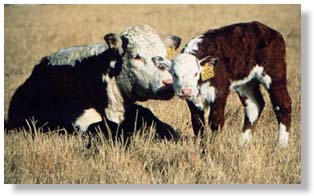Beef Heifer Development
A different philosophy About Heifer Development...
Most heifer development yards have one goal: to get as many heifers pregnant as possible, no matter what the cost.
But we are ranchers, and we understand that not every heifer should be a cow, and selecting for fertility and maternal ability at weaning is tough. Many ranchers, however, are forced to attempt this, as the majority of heifer yards simply grow heifers to be too heavy, and most heifers can and will get pregnant if they are heavy enough, whether they have the genetics for fertility and stayability or not.
Heifer Development Presents a Challenge
With the genetics for growth that the nation's cowherd has developed, it is difficult, even when low-quality roughage based feedstuffs are used, to keep heifers from getting too fleshy when they remain in the feedyard from weaning to breeding. It does a rancher no good if his heifers get pregnant as yearlings, because we allowed them to by getting too big, only to fall out of the herd as two-, three-, and four-year olds. Our goal is to develop heifers in a low-cost, low-maintenance  environment, that helps ensure that only heifers that will become productive, low-cost, mature cows get pregnant in the first place.
environment, that helps ensure that only heifers that will become productive, low-cost, mature cows get pregnant in the first place.
Our Program
Our program begins just as most other heifer programs do. Heifers are received at weaning; processed, identified, and placed on a high-quality, highly nutritionally starter ration for approximately 30 days, or go directly to wheat or rye pasture. They are monitored closely for health and eating problems, and, when they have shown us that they are ready, that they are eating and healthy beyond the stress of weaning, they are transferred to cornstalks, where they will begin to display their abilities of becoming low-cost, forage utilizing animals. Here, they are supplemented with protein to allow them to utilize the low-cost forage that the cornstalks offer.
Heifers remain on cornstalks until approximately 60 days prebreeding. They then return to our yard, where they are weighed, and put on a ration that will target them to a weight that is 65% of their estimated mature weight. Some heifers remain with us for estrous synchronization and artificial insemination in our yard, and even stay longer to go to our own grass and our own heifer bulls, but many leave to go home to the ranch, where our crew travels to artificially inseminate them at home. This allows ranchers to utilize their own forage and decreases the total cost of development.
Our Feedstuffs
We have available to us several thousand acres of aftermath forage from crops grown in Morgan and Yuma counties of Colorado. Heifers can be rotated through these circles to consistently offer them adequate forage for gain.
As far as feedstuffs in the feedyard, heifers are fed balanced rations based on the use of roughage based feeds, many of which are consistent, low-cost byproducts that help ensure extremely low ration costs, with maintenance of quality.
Other care
At all times heifers are monitored for health and eating disorders; however, we find that our program presents a lower stress environment to calves, and heifers stay healthier and happier throughout our program. Cattle are and should be foraging animals, and remain healthier in a forage-based, range environment.
Endpoint Options
Most ranchers find that even though heifers are developed through our low cost program, the majority of them do get pregnant within their breeding seasons. We recommend that only heifers that breed on the first cycle, or on the front end of the breeding season, be kept as replacements, as these are the heifers with the genetics for early and consistent fertility. Other heifers can be marketed as bred heifers, or return to the feedyard as feeders. Because these heifers have been developed in a low-cost manner, they usually are sold at a profit.
